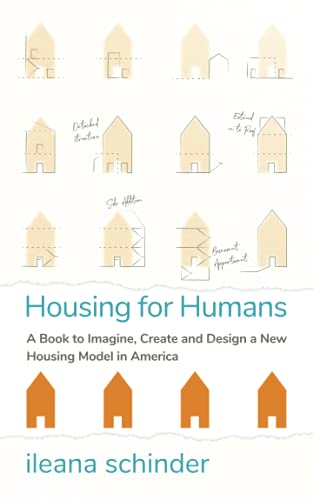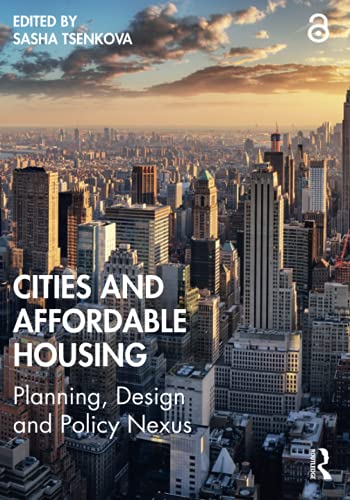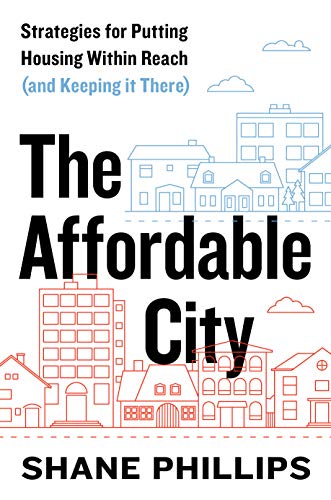
1

2

3

4

5
For many Americans, it’s becoming increasingly difficult to attain affordable housing, despite it being a basic human need. In the States, affordable housing continues to be a prominent talking point with home prices continuing to reach record highs. Millions of Americans every year are impacted because of the shortage of affordable housing. The same is true in towns and cities across the globe. Here is a selection of the top five books written by experts in the field of affordable housing design.
1
Within Housing For Humans, Ileana Schinder explores how America – a country so vast and rich – could have looked away from a housing crisis that reached humanitarian proportions from coast to coast. Housing For Humans is an exploration of Ileana’s discovery. It’s the result of years of changing basements into family rooms, welcoming in older generations adding to rental income, and bringing spaces to life. The book delves into Ileana’s experiences as both an architect and an immigrant, her insight into how the American housing crisis came to be and considers how layers and generations of zoning, financial and cultural waves built and demolished concepts of housing and family models.
2
This book provides a comparative perspective on housing and planning policies affecting the future of cities, focusing on people- and place-based outcomes using the nexus of planning, design and policy. A rich mosaic of case studies features good practices of city-led strategies for affordable housing provision, as well as individual projects capitalising on partnerships to build mixed-income housing and revitalise neighbourhoods. Twenty chapters provide unique perspectives on diversity of approaches in eight countries and 12 cities in Europe, Canada and the USA. Combining academic rigour with knowledge from critical practice, the book uses robust empirical analysis and evidence-based case study research to illustrate the potential of affordable housing partnerships for mixed-income, socially inclusive neighbourhoods as a model to rebuild cities. Cities and Affordable Housing is an essential interdisciplinary collection on planning and design that will be of great interest to scholars, urban professionals, architects, planners and policy-makers interested in housing, urban planning and city building.
3
In Missing Middle Housing, Parolek, an architect and urban designer, illustrates the power of these housing types to meet today’s diverse housing needs. With the benefit of beautiful full-color graphics, Parolek goes into depth about the benefits and qualities of Missing Middle Housing. The book demonstrates why more developers should be building Missing Middle Housing and defines the barriers cities need to remove to enable it to be built. Case studies of built projects show what is possible, from the Prairie Queen Neighborhood in Omaha, Nebraska to the Sonoma Wildfire Cottages, in California. A chapter from urban scholar Arthur C. Nelson uses data analysis to highlight the urgency to deliver Missing Middle Housing.
4
This collection of stories and intimate documentary photographs delivers lessons in how we can work together to improve the lives of our neighbors. On the US-Mexico border, in farm country, in Rust Belt cities, and in pockets of blight and abandonment, the examples show that architecture is about human relationships and shared ambitions, and how buildings can support and embody them.
5
Shane Phillips believes that effectively tackling the housing crisis requires that cities support both tenant protections and housing abundance. He offers readers more than 50 policy recommendations, beginning with a set of principles and general recommendations that should apply to all housing policy. The remaining recommendations are organized by what he calls the Three S’s of Supply, Stability, and Subsidy. Phillips makes a moral and economic case for why each is essential and recommendations for making them work together. There is no single solution to the housing crisis—it will require a comprehensive approach backed by strong, diverse coalitions. The Affordable City is an essential tool for professionals and advocates working to improve affordability and increase community resilience through local action.

1
Within Housing For Humans, Ileana Schinder explores how America – a country so vast and rich – could have looked away from a housing crisis that reached humanitarian proportions from coast to coast. Housing For Humans is an exploration of Ileana’s discovery. It’s the result of years of changing basements into family rooms, welcoming in older generations adding to rental income, and bringing spaces to life. The book delves into Ileana’s experiences as both an architect and an immigrant, her insight into how the American housing crisis came to be and considers how layers and generations of zoning, financial and cultural waves built and demolished concepts of housing and family models.

2
This book provides a comparative perspective on housing and planning policies affecting the future of cities, focusing on people- and place-based outcomes using the nexus of planning, design and policy. A rich mosaic of case studies features good practices of city-led strategies for affordable housing provision, as well as individual projects capitalising on partnerships to build mixed-income housing and revitalise neighbourhoods. Twenty chapters provide unique perspectives on diversity of approaches in eight countries and 12 cities in Europe, Canada and the USA. Combining academic rigour with knowledge from critical practice, the book uses robust empirical analysis and evidence-based case study research to illustrate the potential of affordable housing partnerships for mixed-income, socially inclusive neighbourhoods as a model to rebuild cities. Cities and Affordable Housing is an essential interdisciplinary collection on planning and design that will be of great interest to scholars, urban professionals, architects, planners and policy-makers interested in housing, urban planning and city building.

3
In Missing Middle Housing, Parolek, an architect and urban designer, illustrates the power of these housing types to meet today’s diverse housing needs. With the benefit of beautiful full-color graphics, Parolek goes into depth about the benefits and qualities of Missing Middle Housing. The book demonstrates why more developers should be building Missing Middle Housing and defines the barriers cities need to remove to enable it to be built. Case studies of built projects show what is possible, from the Prairie Queen Neighborhood in Omaha, Nebraska to the Sonoma Wildfire Cottages, in California. A chapter from urban scholar Arthur C. Nelson uses data analysis to highlight the urgency to deliver Missing Middle Housing.

4
This collection of stories and intimate documentary photographs delivers lessons in how we can work together to improve the lives of our neighbors. On the US-Mexico border, in farm country, in Rust Belt cities, and in pockets of blight and abandonment, the examples show that architecture is about human relationships and shared ambitions, and how buildings can support and embody them.

5
Shane Phillips believes that effectively tackling the housing crisis requires that cities support both tenant protections and housing abundance. He offers readers more than 50 policy recommendations, beginning with a set of principles and general recommendations that should apply to all housing policy. The remaining recommendations are organized by what he calls the Three S’s of Supply, Stability, and Subsidy. Phillips makes a moral and economic case for why each is essential and recommendations for making them work together. There is no single solution to the housing crisis—it will require a comprehensive approach backed by strong, diverse coalitions. The Affordable City is an essential tool for professionals and advocates working to improve affordability and increase community resilience through local action.
© Five Books 2026